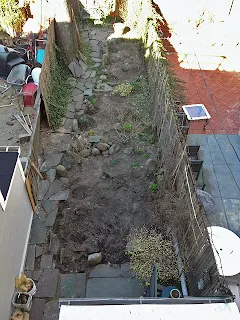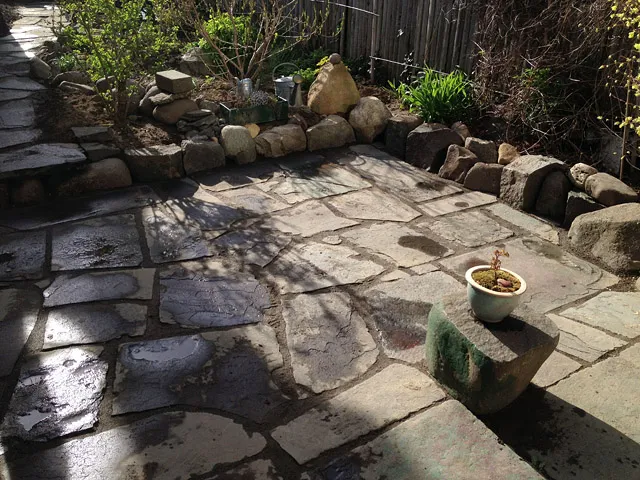It was cloudy at the farm, breezy, the air moist, still warranting a jacket. On my last trip, around the equinox of March, I saw growth in every row and was pleased. This trip there was still more growth, yet also signs of trouble.

Twenty two 40-foot rows of garlic and one row of saffron crocus.
Last season, at the upstate farm (below) growth was luxurious by mid April. Everything was grown in a bed of local compost. The season was also warm, all winter, and there wasn't much wind in this protected spot. Note how good the Griselle shallots look in the center row -lush, green, spidery foliage.

These are the Turban variety strain 'Thai Purple.' Like its sibling 'Tuscan,' these came up last December and continued to grow throughout the cold winter. Turban strains are earliest to harvest, and that explains their large size at this date. My experience suggests that the yellow discoloration of the leaves is due to winter damage.
At this point, most of the garlic looks healthy, despite the raw attitude of the bare soil, lack of compost and mulch. Above the Creole strain 'Burgundy.'
An Asiatic strain, 'Asian Tempest,' that I had some concern about was isolated from the rest. So far, so good.
The Purple Stripe variety strains, like 'Chesnok,' come up slow, with wider leaf angles than the other hardneck varieties. This strain did poorly last season, at the upstate farm, and I blame poor seed garlic. I hope this new supply from a better farm grows larger and healthier.
Now look at this. One of the advantages to planting in orderly rows is the ease with which you can account for your planting. Clearly this bed is in the red. Take another look at last season's bed of Griselle at the upstate farm in April. I didn't lose one of those -each and every one a perfectly healthy specimen. I lost none in storage, and had them tested for nematode, which came up negative. So this is a major disappointment. The soil is actually quite similar here to the soil at last season's farm (although that
was amended with compost). The rain? No, shallots should be able to handle cold and rain over winter. Fertilizer? Maybe, although I did add slow-releasing organic fertilizers before planting and again in late March. Lime? Did that, too, in quite the same manner as last season's upstate farm (which had an even lower pH). Hmmm.
This strikes me as a generally healthy looking shallot, although less healthy than last season's specimens. Look at the one behind. Not so good. Unlikely that this is a fertilizer, pH, temperature, or water problem when one is good and its neighbor not good. That kind of irregularity tends to mean only one thing -
pests.
An adjacent row of garlic, Porcelain variety strain 'German Hardy,' showed a few weak and stunted plants. Not good. I dug one up, careful to maintain an envelope of soil around the roots.
AACCKK! WTF? Oh, this could be very bad. I knew I shouldn't have planted anything from New York State farm sources, but I did. The seed was clean, in great shape, after last year's experience I knew what to look for, and the farmer looked me in the eye and said it was good. I thought I should have this strain and that desire could be the undoing of my entire crop.

First question -what is that black stuff? Fungus, yes? Also the white fluff? My first reaction was emphatically
White Rot,
Sclerotium cepivorum! It is the worst thing you can get in your garlic or onion field beside garlic bloat nematode,
Ditylenchus dipsaci. White Rot favors cool and wet temperatures (check) but this black fungus seems a little large for the black sclerotia which is often described as poppy seed-sized. Have I grown a super White Rot? I pulled three stunted garlic plants, all from the same bed of German Hardy (and adjacent to the Griselle shallots) and inspected them, then disposed each in a trash bag brought back to Brooklyn.
I didn't want to leave the farm this way, but culling poor performers was my last task.
Man v Maggot
The next morning I headed outside to more closely inspect the garlic I had tossed in the trash. I didn't want to do this on the farm for fear of spreading pestilence around. I shook the soil off of the plants, discovering that the roots were healthy and the black fungus was not a collection of orbs, but a sheet type, similar to lichen in form and almost rubbery. The black fungus was only attached to the old clove skins.
As I said before, the roots were healthy on all three specimens, but the clove was rotting from the inside. It's possible the black and white fungal matter were completely secondary and not indicating White Rot.
I scraped away some soil on the final specimen and found something. Movement.
Worms, or rather maggots, Onion Maggots,
Hylemya antiqua -a serious pest that is difficult if at all possible to get rid of. It was only then that I made a connection to my adjacent, poorly growing Griselle shallots. Where did they come from? Probably in the field already (they overwinter in the soil), or they migrated from a nearby field via tractor or even from wild onions or garlic in the grass alongside my field. So far the obvious damage is on the west side of my acre. Now I need to get back to pluck all the stunted shallots and garlic and dispose of them in trash bags. Once these maggots pupate and morph into flies they will be impossible to contain. There are no useful controls. Farming is hope in action.

















































